Gayle Irwin's Blog, page 12
April 9, 2019
Pet Loss and Grief: A Personal Journey


“No one can truly understand why dogs are called “man’s best friend” until they have experienced the loss of one.”
“When the cat you love becomes a memory, that memory becomes a treasure.”
(quotes from https://www.loveliveson.com/loss-of-pet-quotes/)
Every journey with a pet is unique. Each death of a pet is unique. As I research write these words, my husband and I are dealing with the final days of our beloved Mary. A springer/cocker mix, Mary has been our special companion for more than six years. We adopted her when she was almost seven, nearly a year after the loss of another much-loved dog. Mary’s former owner had passed away suddenly, and Mary went into rescue; we learned about her and drove 300 miles one way to meet and adopt her. She has brought much joy and comfort to us during the time we’ve been blessed to call her “ours.”
Trained as a therapy dog by her previous owner, Mary has positively impacted many lives. I’ve written two children’s books about her (and am in the final stages of completing a third), and together, we’ve visited libraries and schools. Mary’s kind, sweet nature won over children and adults alike. She provided comfort for elderly folks, and to my husband and me. Her intuition for people who were down physically and emotionally has been incredible to observe, and her patience and affection for other animals allowed us to bring in another dog 18 months ago who needed her guidance and friendship. My husband and I worry how Jeremiah, our rescued Shih Tzu, will handle Mary’s passing.
This is not the first time we’ve faced the death of a beloved pet. In our 20 years together, my husband and I have experienced the passing of two dogs and one cat, and before we met, we grieved the loss of animals as children and younger adults. However, the experience never gets easier. Each pet has brought love, fun, joy, and devotion to our lives, touching our hearts in their own special way. And, their passing leaves a void. Yet, their lives leave memories galore!
Each pet parent’s experience with the loss of a beloved animal is a personal journey. Some people grieve for months, even years. Just as the loss of a human friend or loved one pierces the heart, so does the loss of a beloved animal companion. And just as the journey of grief for another person is personal and unique, so is the journey of pet loss.
Experts note the stages of grief after losing a pet are similar to those experienced at the loss of a human loved one: denial, anger, guilt and acceptance. They also agree a person needs to grieve the death of a pet. Some adults may try to keep their sadness, guilt, and other emotions in-check, being embarrassed to acknowledge how their animal’s death affects them; however, bottling up those emotions isn’t healthy. A person needs to accept and acknowledge the depth of grief they feel in order to start the path of healing. Also, don’t let other people tell you how you “should” feel – as noted earlier, this journey is a personal one and other people are NOT you and you are NOT them. Talk with friends and family who are understanding and empathetic, those you believe will be of help to you and with whom you feel comfortable sharing. Some communities, either through veterinarian’s offices or other organizations, offer pet bereavement support groups; consider going to one. There are also online sites where you can share your thoughts about the loss of your companion, take part in a memorial service, and connect with others who are going through their own pet loss journey.
Whatever your pet loss story, whatever your journey, know that over time your broken heart will heal. And, perhaps one day, another sweet dog, cat, horse, hamster, or other animal will share your love and your life.
Here are a few websites that help pet parents deal with the loss of a beloved animal:
https://www.helpguide.org/articles/grief/coping-with-losing-a-pet.htm/
https://www.pet-loss.net/
http://www.vetstreet.com/our-pet-experts/7-ways-to-cope-with-the-loss-of-a-pet
https://www.avma.org/public/PetCare/Pages/pet-loss.aspx
https://www.psychologytoday.com/us/blog/animal-attachment/201702/tragic-sudden-unexpected-grieving-traumatic-pet-loss
 A POEM FOR THE GRIEVING
A POEM FOR THE GRIEVING Do not stand at my grave and weep.
I am not there, I do not sleep.
I am a thousand winds that blow,
I am the diamond glints on snow.
I am the sunlight on ripened grain,
I am the gentle autumn's rain.
When you awaken in the morning's hush,
I am the swift uplifting rush
of quiet birds in circled flight.
I am the stars that shine at night.
Do not stand at my grave and cry,
I am not there, I did not die...
-Mary Frye (1932)

Published on April 09, 2019 08:04
April 3, 2019
6 springtime dangers for pets
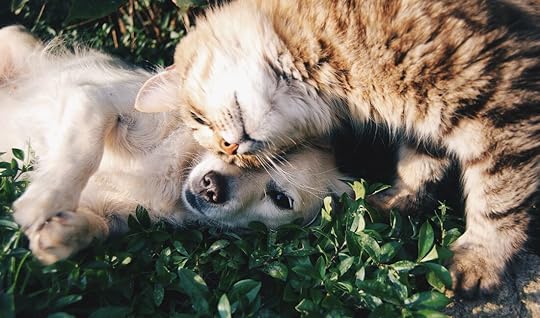 Winter is passing and a new season is teasing. Warmer temperatures and bright sunshine can, and does, give way to rain, and even a few snow showers here and there. But, with the calendar page turned to April now, we know the new season of spring is fast approaching. And most of us rejoice.
Winter is passing and a new season is teasing. Warmer temperatures and bright sunshine can, and does, give way to rain, and even a few snow showers here and there. But, with the calendar page turned to April now, we know the new season of spring is fast approaching. And most of us rejoice.Our pets, too, usually look forward to the change. Dogs spend more time outdoors in the yard, on walks, or at the dog park. Cats bask in sunshine and watch birds and insects through the window. But, with the onset of spring can come hazards. Below are six of which to be aware:
Allergies – Like people, our pets can suffer from springtime allergies. Dogs in particular seem prone to various allergens, such as dust, mold, and pollen. Watch for symptoms such as sneezing, coughing, excessive scratching, and licking and chewing of paws.Easter Baskets – This special spring holiday falls in April this year. One might not think there were hazards in a cute basket, but chocolate eggs and bunnies are toxic for dogs, (especially if they contain baker’s or dark chocolate), and strings of green Easter grass can cause stomach upset if ingested by pets. Small toys also pose a choking hazard.Flowers – People enjoy the bright colors of spring flowers, but did you know several varieties can harm our pets? Lilies are extremely toxic and can be deadly. If you grow these, make sure they are in an area your pets cannot reach. Other spring flowers that can harm dogs and cats include tulips (the bulb is the culprit, so if your animal digs, BEWARE!), daffodils, foxglove, and begonias.Pests and Bugs – With warmth and rain, flowers, and budding trees also come flies, fleas, ticks, and other nasty critters. Therefore, protect your dogs and cats from these harmful bugs. Heartworm is a horrible, yet easily preventable disease, causing suffering and even death. Ensure your pet is tested and treated. And remember to check your dog for ticks after walks in wooded or grassy areas.Household Cleaners – Supplies used for spring cleaning can expose your pet to harmful chemicals like ammonia, bleach, and chlorine. Even all-natural products can cause health issues. Experts advise keeping pets in a separate room until the surfaces you’ve cleaned are dry. Yard, Grass, & Weed Products – Products used in landscaping, such as fertilizers, herbicides, and insecticides, can also harm animals. Therefore, keep your pet indoors when applying such products – better yet, use items that don’t harm the environment, pets, and children. If you believe your pet has ingested any type of lawn or garden product (or any other toxin), contact your vet immediately or call the ASPCA’s Pet Poison Prevention Hotline at (888) 426-4435.
There are many other spring hazards that can harm our beloved furry friends. For more information and additional safety tips, visit these websites:
https://www.aspca.org/pet-care/general-pet-care/springtime-safety-tips
https://www.petful.com/pet-health/springtime-dangers/
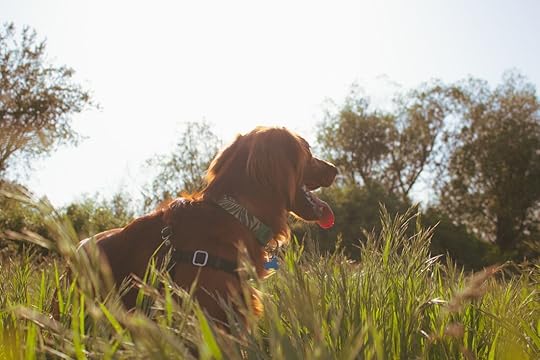
Published on April 03, 2019 05:31
March 27, 2019
dig it! some dogs do
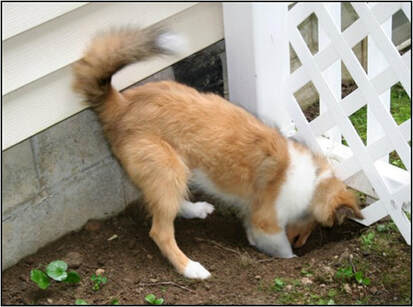 Certain dog breeds, like terriers and dachshunds, were originally bred to dig in order to go after vermin in farmer’s fields. Therefore, these types of dogs are born diggers. Other types of dogs may dig due to boredom, in order to keep cool in summer, or they are seeking prey, such as mice or insects.
Certain dog breeds, like terriers and dachshunds, were originally bred to dig in order to go after vermin in farmer’s fields. Therefore, these types of dogs are born diggers. Other types of dogs may dig due to boredom, in order to keep cool in summer, or they are seeking prey, such as mice or insects.If you don’t want your dog digging up every square inch of your back yard, there are several things you can do to alleviate the situation.
If you’re dog is seeking comfort from the heat, bring it inside more often; make sure the outdoor shelter is comfortable, and that your pup has plenty of access water. If your dog is still digging, try setting aside a special area where such behavior is okay.
If you believe your dog is bored, spend more time with your furry friend. Play fetch in the yard; go for an extra walk; have more cuddle-time on the couch (dogs, TVs, and couches go well together!); provide interactive toys inside and outside the house; teach your dog new commands or tricks and spend about 10 minutes each day in training; set up an agility course in the yard or join an agility club – any of these or a combination of such activities are great ways to provide extra entertainment for your pet as well as added time with you.
If you think your dog is digging to go after “prey,” the Humane Society of the United States suggests: “Search for signs of burrowing animals, then use safe, humane methods to fence them out, exclude them or make your, yard or garden unattractive to them.” However, “Don't use any product or method that could be toxic or dangerous to your pets or other animals. Anything that poisons wildlife can poison your dog, too.”
Dogs also dig for other reasons, such as trying to escape the yard (perhaps your dog is afraid of something, like as a neighbor dog that barks and growls from across the fence, or someone has been teasing and harassing your dog from the alley), or your intact dog is trying to get out of the yard to search for a mate, or your dog may be burying treats and food Trying to understand the “why” of digging can help you address the behavior and work on changing it as needed.
Also keep in mind, many cats also enjoy digging in dirt.
For more information on why dogs dig and how to take charge of the issue, visit these websites:
https://www.caninejournal.com/how-stop-dog-digging-holes/
https://www.akc.org/expert-advice/training/why-do-dogs-dig/
https://yourdogadvisor.com/dog-is-a-digger/

Published on March 27, 2019 06:57
March 19, 2019
your garden and your pets
 Spring officially arrives on Wednesday, March 20, and I am sure almost everyone is ready for warmer temperatures, sunshine, and bountiful color!
Spring officially arrives on Wednesday, March 20, and I am sure almost everyone is ready for warmer temperatures, sunshine, and bountiful color!This is the time of year when many of us dream of vibrant flowers in shades of red, yellow, purple, and blue, livening up the lawns that have been white or brown for so long. We envision working in our yards and gardens, preparing the soil (if it’s not still frozen), and we muse over seed catalogs and/or visit home and garden centers pondering ideas for making our residences sparkle with rainbow colors. We may even visit Home and Garden Shows, like the one coming to my town this weekend, seeing the outdoor trends and thinking how we might implement those plants, ornaments, and water features into our outdoor spaces.
In addition to spring’s arrival, the month of March is Pet Poison Prevention Awareness Month. Did you know many types of plants and flowers are poisonous to pets and that some garden products and insecticides are toxic to our furry friends as well? As you think about spring preparation and planting, and if you have pets, keep in mind some plants and preparation products are hazardous to animals.
For example, tulips, azaleas, and lilies are toxic to dogs and cats. If you plant these flowers, you may need to erect a decorative fence around them – and keep your dog on a leash when in the area of planting and keep your cat indoors.
Many yard and lawn products are also toxic to our pets, including Roundup, which is highly used on lawns, gardens, and fields. In fact, lawn and garden products, such herbicide and fertilizer, insecticides, rodenticides, and plants are among the top 10 pet poison calls received by the (American Society for the Prevention of Cruelty to Animals (ASPCA) in 2017.
Don’t let your beloved furry friend become one of those statistics; plan well with safety in mind for your spring and summer planting!
If you believe your pet has ingested a potential poison, contact your vet immediately as well as the ASPCA Animal Poison Control Hotline; the number is (888) 426-4435
Three great references you should view and read as you plan your spring planting include:
ASPCA.com – Toxic and Non-Toxic Plant List:
https://www.aspca.org/pet-care/animal-poison-control/toxic-and-non-toxic-plants
YourDogAdvisor.com – Garden Safety: Toxic Plants and Other Hazards in Your Own Backyard:
https://yourdogadvisor.com/garden-safety/
PetPoisonHelpline.com – Things in Your Yard That Are Poisonous to Pets:
https://www.petpoisonhelpline.com/pet-safety-tips/things-in-your-yard-that-are-poisonous-to-dogs-cats/

Published on March 19, 2019 08:13
March 13, 2019
honoring america's k9 heroes
 Today, March 13, is America’s National K9 Veterans Day. Military working dogs are vital to America’s military. Sentry duty, explosive detection, and casualty location are just a few of the jobs these special animals are trained to do.
Today, March 13, is America’s National K9 Veterans Day. Military working dogs are vital to America’s military. Sentry duty, explosive detection, and casualty location are just a few of the jobs these special animals are trained to do.The different branches of the military use dogs as does the Coast Guard, which is under the auspices of the Department of Homeland Security. Many of these animals go on patrol with their handlers, a great number are used to sniff out bombs and drugs, and some even learn to leap from helicopters for search and rescue and other missions.
Whether conducting searches, sniffing for explosives or drugs, or going on patrol, the military’s faithful canines serve their handlers, their units, and our country.
Dogs and other animals have served in war for centuries. Whereas they may have been “disposable” before, today’s military K9s are important members of their service’s units. A memorial for war dogs was dedicated in 2006.
There is also a strong movement in our nation that, upon retirement, a military working dog goes to live with its handler or its handler’s family. For decades, these brave canines were classified as “equipment” and often left overseas. The American Humane Association has worked with Congress to change this and to reunite retired military working dogs with their handlers as well as provide service and therapy dogs for human veterans in need.
Military heroes are both two-legged and four-legged, and oftentimes, they work together to serve our country. Let’s remember and honor those who keep us safe!
Learn more about K9s in the military and this special day to honor them here: https://www.military.com/veterans-day/k9-veterans-day.html
https://www.uswardogs.org/category/news/

Published on March 13, 2019 11:54
March 6, 2019
Choosing a Pet Food - Not an easy task
 When feeding time comes around, does what your pet ingests really matter? The answer is a resounding YES!
When feeding time comes around, does what your pet ingests really matter? The answer is a resounding YES!Pet food recalls happen frequently. Salmonella, Listeria, Vitamin D, even poisons and meds like phenobarbital have made it into commercial dog and cat food. Whether the pet food is dry, canned, or raw, recalls take place frequently, and it seems to not matter if the brand is considered quality, recommended by veterinarians (ie, Hill’s Science Diet), or poorly manufactured – pet foods are susceptible to manufacturing problems and recalls.
Since my springer mix, Mary, was diagnosed with cancer a few months ago, I’ve been more conscious about what food I feed her. I alternate between giving her “people food,” such as chicken, turkey, and lean burger, a quality grain-free kibble (grains contain starches, and carbohydrates, such as potatoes and rice can cause cancer cells to grow), and grain-free FreshPet, a semi-cooked pet food that is refrigerated. FreshPet has never experienced a recall, and upon reading the ingredients found in the grain-free turkey roll, I discovered many of those ingredients (such as blueberries and spinach) are recommended in a cancer diet for pets. I’m fortunate that a pet supply store in my community carries this brand and this type of food in particular (FreshPet is found in many stores, but not necessarily the grain-free turkey food). If you look online, some people believe the product contributed to their pet’s death while others highly praise the product. Mary has been eating it off and on for the past few months, and she is doing fine.
Like any pet food product, one can find positive reviews and negative ones. Choosing a pet food is not necessarily easy.
Therefore, I highly encourage pet owners to conduct research; don’t just buy a food product because “that’s what we’ve always fed our animals.” Talk with other pet owners. Talk with your veterinarian. Do online research. Sites such as DogFoodAdvisor.com, Petful.com, and ConsumerSearch.com can help you find good food for your pets. Many sites also list pet food recalls, including the American Veterinary Medical Association (AVMA) and the Federal Food & Drug Administration (FDA).
Even if you feed your pet “human food,” such as chicken, beef, and turkey, spinach, blueberries, and kale, you should keep an eye open and an ear to the ground regarding recalls and alerts (remember the recent Romaine Lettuce problem?) These foods can also become contaminated with E. coli, Salmonella, and other bad things. I thoroughly wash vegetables and fruits and cook meats before feeding such things to my dog just as I do before eating these products myself.
Whether you feed your pet kibble, canned pet food, raw, or partially cooked human food, do your homework – research, investigate, discuss, and then choose what you think is best for your furry friend. Even if you pay more to feed your pet, a trip to the veterinarian and the potential (or actual) loss of your companion are much higher costs than providing the best healthy diet possible.
For more information as well as guides on buying pet food and discovering which foods have recalls, visit the following sites:
https://yourdogadvisor.com/best-dog-food/
https://www.dogfoodadvisor.com/
https://pets.webmd.com/features/pet-food-ingredients#1
https://www.petfoodindustry.com/topics/253-pet-food-recalls
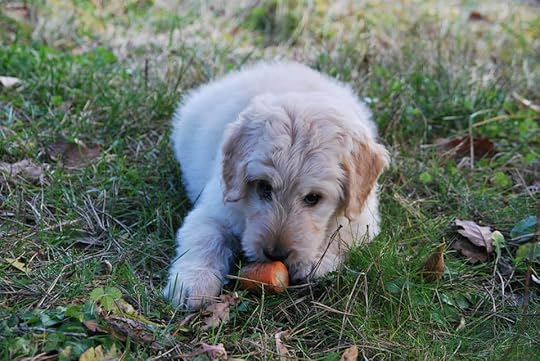
Published on March 06, 2019 06:51
February 27, 2019
Is CBD Oil Right for Your Pet?
 For many pet parents who hear these words from their veterinarian, “I’m sorry – your dog/cat has cancer,” turning to CBD products (those made from Cannabidiol, a naturally-occurring compound found in cannabis) has become the “in-thing.” Many articles have been written about the effectiveness of CBD products (especially oil) in the treatment of cancer.
For many pet parents who hear these words from their veterinarian, “I’m sorry – your dog/cat has cancer,” turning to CBD products (those made from Cannabidiol, a naturally-occurring compound found in cannabis) has become the “in-thing.” Many articles have been written about the effectiveness of CBD products (especially oil) in the treatment of cancer.This week, I welcome a guest blogger who provides information on CBD oil, including a guide available for download, and I thank Keliah Kaiser for providing this important information for my blog. Do keep in mind CBD oil and other products may not be available legally where you live. Check your local and state laws before purchasing such items.
Guest Post by Keliah Kaiser – Content Marketing Specialist, Seige Media
There’s a lot of buzz surrounding CBD Oil and how it can keep your dog happy, healthy and even treat existing ailments. You might’ve already heard about the benefits CBD products give to humans, and there’s no doubt the same can be said for dogs.
For those new to CBD Oil, it’s an all natural and legal way to help relieve ailments or behavioral issues for your dog. As a natural treatment method, it has the ability to improves their quality of life, without the side effects of traditional medicine. Despite years of common misconception, CBD oil is vastly different from medicinal marijuana because it contains less than 0.03 percent of THC. This amount isn’t enough to produce psychoactive effects in even the smallest animal.
Yet, you must consider the variety of factors when choosing the right CBD product for your dog. Aside from oil, you also have the option to give your dog CBD treats, capsules and topical ointments. You’ll also want to consider the reason you’re interested in CBD for Fido in the first place. Are you looking to manage medical or therapeutic issues with your dog? Depending on your goal, can determine how you figure out the appropriate dosage.
These are a few of the guidelines to keep track of when you want to keep your dog happy and healthy using CBD Oil. There’s a lot more to learn. Including, how to choose a quality product, dosage guidelines and key questions to ask your veterinarian.
You can find the full details and tips about this in this comprehensive guide to CBD Oil for Dogs.
Published on February 27, 2019 06:30
February 19, 2019
"i'm sorry - your dog has cancer"
 My husband and I heard those words last month from our veterinarian regarding our springer spaniel mix Mary. What started as a skin growth that mushroomed last December also created a tumor on her lung. Speculation is it’s a slow-growing tumor and we should have about a year with her yet. We are to be mindful of her developing shortness of breath and wheezing. Mary is now 13 years old, and she has enjoyed a good life, despite losing her first family prior to us adopting her. We adopted her seven years from English Springer Spaniel Rescue of the Rockies. Although we are thankful the cancer that’s developed is not aggressive nor at an advanced stage, we are saddened to know we’ll once again likely lose a dog to cancer. Mary will be #3.
My husband and I heard those words last month from our veterinarian regarding our springer spaniel mix Mary. What started as a skin growth that mushroomed last December also created a tumor on her lung. Speculation is it’s a slow-growing tumor and we should have about a year with her yet. We are to be mindful of her developing shortness of breath and wheezing. Mary is now 13 years old, and she has enjoyed a good life, despite losing her first family prior to us adopting her. We adopted her seven years from English Springer Spaniel Rescue of the Rockies. Although we are thankful the cancer that’s developed is not aggressive nor at an advanced stage, we are saddened to know we’ll once again likely lose a dog to cancer. Mary will be #3.According to the website Cancer Active, nearly 50% of dogs 10 and older and more than 30% of cats develop cancer. The Truth About Pet Cancer is a documentary-style video series released a few years ago. Some rebuff what’s discussed and asserted in the series, including some of the believed causes attributed to pet cancer. However, learning more about thoughts on environmental factors, pharmaceuticals, and nutrition helps us as pet parents consider what could be impacting our beloved furry friends’ health. A free e-book on pet health is available from the site; if you’re interested, click this link for the download: https://thetruthaboutpetcancer.com/ebook/?a_aid=55b1c500a3d65&a_bid=3a9363c1
The American Animal Hospital Association finds the six most common types of cancer found in dogs are Lymphoma,, which occurs in cells in the lymph nodes or bone marrow; Hemangiosarcoma, a malignant cancer of the blood vessels; Mast cell tumors, often first seen on the skin and go inward to tissue and organs, as in Mary’s case; Melanoma, a type of skin cancer, which often starts in the mouth of a dog; Osteosarcoma, cancer of the bone; and Mammary, which is often malignant, and usually found in unspayed female dogs or those spayed after two years of age.
Cancer Veterinary Centers in Florida says the primary types of cancers that cats develop are Lymphoma, Feline Leukemia Virus, Mammary Cancer, Squamous cell carcinoma (Skin Cancer), and Fibrosarcoma, which develops from fibrous connective tissue.
There are several treatment options for animals with a cancer diagnosis, including surgery, radiation, and chemotherapy. Like people, animals undergoing this treatment often have side effects, from hair loss to immunity suppression. Chemotherapy is most often used when cancer has metastasized or is an aggressive type that can easily metastasize. The cost for such therapy varies, but often runs into thousands of dollars, and though there is no guarantee for a cure, many times there is hope for a longer life, depending on the type of cancer.
There are holistic alternatives. Retired veterinarian Dr. Allen Schoen, one of the vets featured in The Truth About Pet Cancer series, says, “Nutritional supplements can help in reversing or preventing the cachexia, or muscle wasting associated with cancer … They may enhance the immune system and decrease the incidence of metastases.” Diet can also help. Dr. Greg Ogilvie, formerly of Colorado State University who now practices in California, helped develop a nutritional plan that “should be comprised of a relatively low amount of simple carbohydrates, modest amounts of fats (especially omega-3 fatty acids), and adequate amounts of highly bioavailable proteins,” reports a story in Whole Dog Journal.
Some even tout ditching the kibble, especially those with grains, and providing people food, such as organic chicken, kale, spinach, apples, and cottage cheese. There is a strong movement for feeding a raw diet; I prefer to cook my pet’s food, at least somewhat, due to potential bacteria in raw meat.
Here is what we are doing with Mary: Alternating between “people food,” as noted above and giving her FreshPet and occasionally no-grain kibble (and I pay close attention to pet food recalls and brands that have been recalled in the past – I don’t feed those to her; that’s one reason I chose FreshPet). I also provide her with Bixby Immunity Booster and fish oil supplements, which I often blend into a smoothie mixture of kale, spinach, carrots, blueberries, and chicken broth. I sprinkle this especially on dry dog food and chicken, turkey, or turkey burger that I cook for her. FreshPet already has those ingredients so I don’t need the veggie/fruit smoothie with it.
If your pet has been diagnosed with cancer, I suggest conducting a lot of research, talking to others who have been where you are (or are going through like you). I also suggest not only talking with your usual vet, but also consulting with a holistic vet. Choose the route you think is best for you and your pet.
Find more information on pet cancer and potential helps here:
https://caninecancerdiet.com/soft-tissue-sarcoma-in-dogs/
https://caninecancerdiet.com/lung-cancer-in-dogs/

Published on February 19, 2019 04:30
February 13, 2019
6 Benefits of an emotional support animal
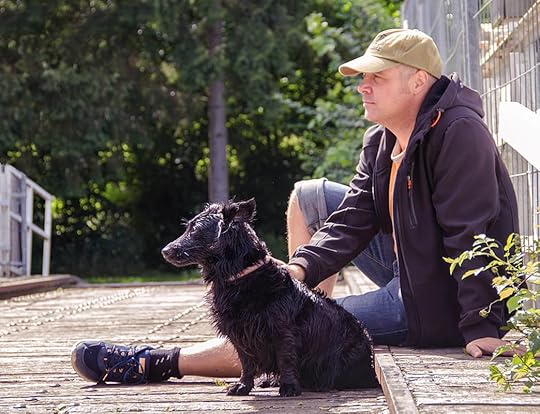 Every dog owner knows the joy of having a dog; they give us companionship, love, and care. Dogs are known as man’s (and woman’s) best friend. However, for people who face emotional and physical challenges, the presence of a dog can be significant to their daily life. Dogs offer support and comfort, helping people living with issues that affect their lives, such as mobility, blindness, deafness, anxiety, and post-traumatic stress disorder.
Every dog owner knows the joy of having a dog; they give us companionship, love, and care. Dogs are known as man’s (and woman’s) best friend. However, for people who face emotional and physical challenges, the presence of a dog can be significant to their daily life. Dogs offer support and comfort, helping people living with issues that affect their lives, such as mobility, blindness, deafness, anxiety, and post-traumatic stress disorder.I am happy to welcome Cody Oelker from US Service Animals.org as a contributor to this week's blog. He reached out to me with the idea of a guest post on Emotional Support Animals, and together we created the post you see here. We hope you enjoy the read, and if you or someone you know would benefit from an Emotional Support Animal, we encourage you to speak to a mental health provider about having such a companion.
Most of us recognize guide dogs which help blind people and service dogs help those with limited or no mobility. Other types of animals assist people who experience emotional trauma. Those can be dogs, cats, rabbits, even guinea pigs, which are also used as therapy animals, visiting schools, libraries, hospitals and nursing homes.
Emotional Support Animals (ESAs) provide emotional support and comfort to their owner in the form of affection and companionship. Although all dogs are emotionally attached to their owner, to be legally considered as an emotional support animal, the animal needs to be prescribed by a licensed mental health professional to a person living with a mental disability. A therapist must examine the person and decide that the presence of an Emotional Support Animal is needed to ease anxiety and help him or her focus on life.
Benefits of an Emotional Support Animal
ESAs help ease anxiety, depression, and certain phobias. These special animals provide many mental and emotional benefits to people living with disabilities. They are intelligent creatures that psychologically impact their owners by offering reassurance and companionship. Other benefits of having an Emotional Support Animal in your home include the following:
Provides friendship: To a person living with a mental or emotional disability, an Emotional Support Animal is just like a friend that stays with you during the toughest time in life. They help you cope with the treatment process and accompany you to many places, thereby preventing you from feeling lonely and isolated at any time. However, ESAs are not allowed in all public places like service dogs. Be sure to know where in your community an Emotional Support Animal is welcome. Under the Air Carrier Access Act, ESAs can travel in the cabin of an airline These animals can also serve as companions you can talk too and play around with whenever you feel depressed or sad.Reduces stress: Spending time with an Emotional Support Animal can help reduce stress, especially for people who are not sociable or those who find it difficult to interact with others. Just like other stress-relieving methods, spending time with your dog or cat releases endorphins, known as the feel-good hormones to the body. These hormones help the body relax and find relief from stress.Keeps you distracted and uplifts your emotions: People who have mental disability think a lot and have their minds running around at all time. An Emotional Support Animal helps to keep your mind off issues that might be bothering you. They reduce anxiety, help you remain calm, cheerful and optimistic and increase your self-esteem.Provides motivation: Some days, you might feel zero motivation to get out of bed due to depression, fatigue, pain, or lack of motivation. An ESA can be the motivation you need at that point. They need people to take care of them: feed, exercise, medical attention. Your responsibility can be your lifeline. Dogs can also assist you by doing amazing things; they can be trained to bring your medication, open a door, and awaken you from a nightmare. However, these things usually require specialty training.Offers unconditional love: Having an Emotional Support Animal can also help people with a mental disability feel loved, which can be difficult to feel. These animals provide a feeling of connectivity and offer devotion and unconditional love to their ownersGives a sense of purpose: Feeding, caring for, and speaking to an Emotional Support Animal can create a sense of purpose and belonging, and help people with a mental disability adopt a healthier lifestyle.
If you’re experiencing any form of mental or emotional challenges, then you may want to consider an emotional support animal. These four-legged furry companions offer so many benefits to their owners, including helping reduce stress, anxiety, depression; serving as a faithful companion; and giving the owner a sense of purpose while experiencing unconditional love. Talk with your counselor, therapist, or psychologist to learn more about how to obtain an ESA and the benefits you may experience by having one.
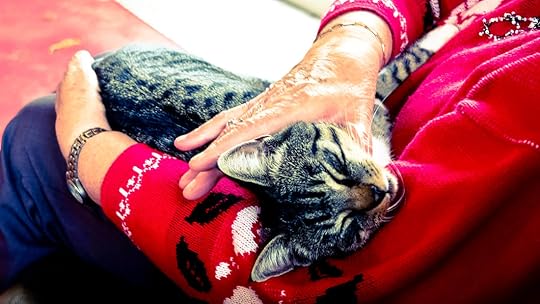
Published on February 13, 2019 06:33
February 6, 2019
the importance of your pet's dental health
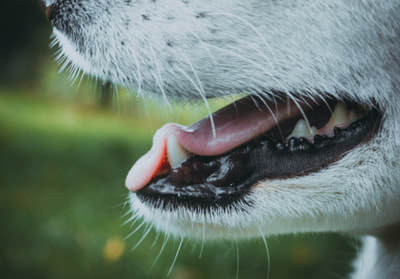 Does your dog’s breath stink? Does your cat’s teeth have a brown coating? These and other signs should trigger you to consider what might be going on with your pet’s dental health.
Does your dog’s breath stink? Does your cat’s teeth have a brown coating? These and other signs should trigger you to consider what might be going on with your pet’s dental health.The majority of dogs and cats will develop dental issues sometime in their lives, oftentimes before the age of three. Periodontal disease affects both canines and felines and starts out as plaque, just like with humans. Not dealt with, plaque can lead to gingivitis, which is an inflammation of the gums. Dental health issues can lead to other medical issues. However, also like humans, such conditions can be abated.
Brushing Your Pet’s Teeth
Did you know you can brush your dog or cat’s teeth? Again like humans, consistent brushing can ward off dental disease.
Specialty toothbrushes, including finger brushes, and flavored toothpastes are created for pets. You can find these at many pet supply stores or your veterinarian. Don’t use people-oriented brushes or pastes – they can harm your pet.
Gradually introduce brushing to your animal, over the course of several days, even weeks. Cats especially dislike new things, like toothbrushes! Therefore, be patient but persistent – and gentle.
Brush your dog or cat’s teeth a few times a week and brush on the outside only. Praise your pet throughout the endeavor.
Why is Pet Dental Health Important?
A pet’s dental health isn’t just about teeth and gums; periodontal disease can affect your pet’s overall health. Kidney and liver disease can result from bacteria flowing from the mouth through the animal’s bloodstream. Sepsis can set in from blood infections. Your pet’s heart can also be negatively impacted from poor dental health, and in particular in small dogs, bone infections can develop.
With cats, an erosion in the tooth called feline resorptive lesions (FRLs) is fairly common, in both young and old kitties. According to International Cat Care, more than 70% of cats five years and older have at least one FRL. “The cause of FRLs is unknown but cells called odontoclasts (which break down the substance of the tooth) are found in the erosions,” according to the website.
February is National Pet Dental Health Month. Keep your pet’s mouth and teeth healthy and you’ll also keep him/her healthier overall!
Resources:
Access a PDF Guide on How to Brush Your Pet’s Teeth, from Petfinder.com, here: https://d17fnq9dkz9hgj.cloudfront.net/uploads/2018/08/brushing-your-pets-teeth.pdf
Click here to watch a veterinarian brush an animal's teeth and learn more about why dental health is so important:
http://www.ardenwoodpethospital.com/pet-health-videos/dental-related-videos/how-to-brush-your-pets-teeth/

Published on February 06, 2019 04:30



